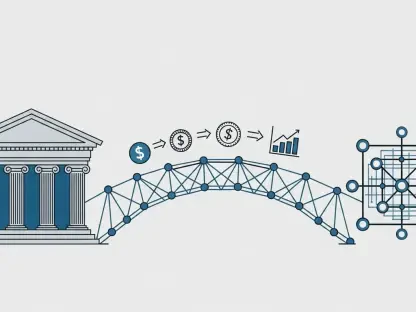In an era where financial markets are becoming increasingly intricate due to the rise of digital assets, algorithmic trading, and evolving compliance demands, the U.S. Securities and Exchange Commission (SEC) has made a groundbreaking move by establishing its AI Task Force, announced on August 1 of this year. This initiative, spearheaded by Chief AI Officer Valerie Szczepanik, signals a profound shift in the approach to regulatory oversight, harnessing the power of artificial intelligence (AI) to address challenges that traditional methods can no longer effectively manage. Far from being a mere response to technological trends, this task force represents a forward-thinking strategy to redefine how financial regulation operates in a rapidly changing landscape. The implications of this development extend beyond the agency itself, influencing market integrity, industry practices, and investment opportunities. As AI becomes a cornerstone of oversight, stakeholders across the financial spectrum are compelled to adapt to this transformative era of regulation.
The Role of AI in Modern Financial Oversight
Revolutionizing Regulation with Technology
The creation of the SEC’s AI Task Force marks a strategic pivot toward embedding advanced technology into the core of regulatory operations, addressing the mounting complexities of modern financial markets. With tools like predictive analytics, the task force is equipped to detect potential fraud before it escalates, while natural language processing (NLP) enables efficient analysis of vast regulatory filings for discrepancies or non-compliance. Real-time market monitoring systems further enhance the ability to spot irregularities in areas such as digital assets and environmental, social, and governance (ESG) reporting. This integration of AI is not merely about adopting new tools but about fundamentally transforming how the SEC approaches its mission. By leveraging these technologies, the agency aims to stay ahead of sophisticated market behaviors that outpace manual oversight, ensuring that regulation keeps pace with innovation in a landscape increasingly defined by complexity and speed.
Beyond technological integration, the AI Task Force is redefining the SEC’s enforcement paradigm by shifting from a reactive stance to a proactive one, a change driven by the sheer scale of data in today’s markets. AI systems can process millions of transactions in seconds, identifying subtle patterns of insider trading or other violations that human analysts might overlook. This capability drastically reduces human error and slashes operational costs, freeing up resources for more strategic initiatives. More importantly, it allows the agency to anticipate risks rather than merely respond to them after damage has occurred. For instance, early detection of market manipulation or non-compliance with sustainability disclosures can prevent systemic issues from arising. This proactive approach is a game-changer, positioning the SEC to safeguard market integrity with unprecedented precision and efficiency, while also setting a benchmark for how regulatory bodies worldwide might evolve in the face of technological disruption.
Enhancing Oversight Through Innovation
Another critical dimension of the AI Task Force’s impact lies in its ability to bridge the gap between traditional regulatory methods and the demands of a digital-first financial ecosystem. By automating labor-intensive tasks such as data analysis and compliance checks, AI empowers the SEC to allocate human expertise to more nuanced, judgment-based decisions. This synergy between machine efficiency and human insight is particularly vital when dealing with emerging sectors like cryptocurrencies, where regulatory clarity is often lacking. The task force’s use of AI to simulate market scenarios and predict outcomes offers a forward-looking perspective, enabling the agency to craft policies that are not just remedial but anticipatory. This innovative approach ensures that oversight is not only about enforcement but also about fostering a stable environment where innovation can thrive without compromising investor protection or market fairness.
Moreover, the adoption of AI within the SEC’s framework serves as a catalyst for cultural change within the agency, embedding a mindset of continuous adaptation to technological advancements. Under Szczepanik’s leadership, the task force is not just implementing tools but also cultivating an ethos of agility and responsiveness. This cultural shift is essential as financial markets evolve at a breakneck pace, driven by technologies that reshape how transactions are conducted and monitored. By prioritizing innovation, the SEC is better positioned to tackle future challenges, whether they stem from new financial instruments or unforeseen market dynamics. This focus on long-term resilience underscores the transformative potential of the AI Task Force, ensuring that regulatory oversight remains robust and relevant in an era where change is the only constant.
Industry Impact and Investment Potential
Private Sector Alignment and Opportunities
The SEC’s AI Task Force is not operating in isolation; it reflects and reinforces a broader trend within the private sector where financial institutions are increasingly turning to AI to streamline compliance and surveillance. Firms are investing in sophisticated platforms to automate regulatory reporting, monitor trading activities in real time, and enhance due diligence processes. The SEC’s embrace of similar technologies validates these efforts and is expected to accelerate industry-wide adoption. This alignment between public and private sectors suggests a future where AI becomes an integral component of financial oversight, blurring the lines between regulatory mandates and corporate strategies. As companies and regulators move in tandem toward tech-driven solutions, the financial industry stands on the cusp of a profound transformation, with efficiency and accountability at its core.
This convergence of regulatory and private-sector priorities is also fueling a surge in investment opportunities, particularly in AI-driven compliance and regulatory technology (RegTech) solutions. Companies specializing in data infrastructure, such as Palantir Technologies and Snowflake, are seeing heightened interest as their platforms become essential for managing the vast datasets required for compliance. Additionally, startups focusing on AI-native tools for fraud detection and risk management are attracting significant venture capital, with billions flowing into this space globally. For investors, this represents a dynamic and rapidly growing sector with substantial potential for returns. However, the appeal extends beyond financial gain; it’s about aligning with a market trend where technological adoption is becoming a prerequisite for competitiveness, positioning early investors to capitalize on the inevitable shift toward AI-centric financial systems.
Market Dynamics and Growth Prospects
The ripple effects of the SEC’s AI Task Force extend into the broader market dynamics, reshaping how financial firms approach compliance and risk mitigation. As the agency sets a precedent with its AI adoption, it creates a benchmark that encourages smaller firms to follow suit, even those with limited resources. This democratization of technology, facilitated by scalable cloud-based solutions and partnerships with tech giants, means that AI is no longer the exclusive domain of large corporations. The task force’s influence thus fosters a more level playing field, where compliance efficiency becomes accessible across the industry spectrum. This trend not only enhances overall market stability but also drives demand for innovative tools, further stimulating growth in the RegTech sector and reinforcing the symbiotic relationship between regulation and technological advancement.
Furthermore, the investment landscape is evolving with a sharp focus on niche areas like ESG compliance, where AI tools are proving invaluable for meeting stringent disclosure mandates. Platforms that analyze and report on sustainability metrics are gaining traction as regulatory pressures mount globally. Investors are increasingly eyeing these specialized solutions, recognizing their dual value in addressing compliance needs and aligning with societal priorities. The momentum behind such tools highlights a broader shift toward purpose-driven investing, where financial returns are intertwined with ethical considerations. As the SEC’s task force continues to champion AI integration, it inadvertently amplifies these market trends, creating a fertile ground for innovation and investment that promises to redefine the financial industry’s future trajectory over the coming years.
Challenges and Governance Needs
Navigating Risks in AI Adoption
While the SEC’s AI Task Force heralds a new era of regulatory efficiency, it also brings to light significant challenges that must be addressed to ensure sustainable progress. One prominent concern is the financial risk posed by the high valuations of AI-focused companies, where forward price-to-earnings ratios often outstrip broader market averages. This overvaluation could lead to market corrections, impacting investors who have heavily backed these firms. Additionally, the increasing regulatory scrutiny over the transparency of AI algorithms presents a hurdle, as opaque systems may conflict with emerging laws in various jurisdictions. These risks underscore the delicate balance between embracing innovation and safeguarding against potential pitfalls, a balance that the task force must navigate to maintain credibility and effectiveness in its mission.
Another layer of complexity arises from the ethical and operational challenges inherent in overreliance on AI systems for regulatory decisions. The potential for unintended biases in algorithms, if not rigorously monitored, could lead to unfair enforcement practices or missed violations. Moreover, the rapid pace of AI deployment may outstrip the development of adequate training for regulatory staff, creating gaps in oversight. These issues highlight the need for a cautious approach, where technological adoption is paired with robust checks and balances. The SEC’s task force faces the dual challenge of pioneering AI use while ensuring that such tools do not undermine the very principles of fairness and accountability they aim to uphold. Addressing these concerns will be critical to sustaining trust among market participants and regulators alike.
Standardizing AI Use for Stability
To counter the risks associated with AI adoption, the SEC’s task force is actively working on establishing governance frameworks that standardize the use of these technologies across regulatory practices. Such frameworks aim to provide clarity on how AI tools should be developed, deployed, and audited, reducing uncertainty for both the agency and the private sector. By setting clear guidelines, the task force seeks to mitigate issues like algorithmic opacity and ensure that AI systems align with legal and ethical standards. This standardization is particularly crucial in a landscape where state-level regulations on AI transparency are becoming more stringent, creating a patchwork of compliance requirements that could complicate nationwide implementation. A unified approach promises to streamline these challenges, fostering a more predictable environment for innovation.
Equally important is the role of these governance efforts in building confidence among stakeholders who might otherwise be wary of AI’s role in regulation. Transparent policies and accountability mechanisms can reassure financial firms and investors that AI-driven oversight will be equitable and reliable. The task force’s commitment to collaboration across agencies further enhances this effort, ensuring that diverse perspectives inform the development of these standards. By prioritizing governance, the SEC is not just addressing immediate risks but also laying the foundation for long-term stability in an AI-integrated regulatory landscape. This proactive stance is essential for balancing the transformative potential of technology with the imperative to protect market integrity, setting a precedent for how other regulatory bodies might approach similar challenges in the future.
Building a Future-Ready Financial System
Long-Term Vision for Regulation
The SEC’s AI Task Force is not merely a response to current market demands but a deliberate step toward future-proofing the financial system against emerging challenges. Under Valerie Szczepanik’s leadership, the initiative embodies a vision of embedding innovation into the agency’s culture, ensuring that it remains agile in the face of rapid technological and market shifts. This long-term perspective is vital as new risks, from novel financial instruments to unforeseen systemic vulnerabilities, continue to evolve. By prioritizing adaptability, the task force positions the SEC to anticipate and address these issues before they become crises. This forward-thinking approach signals to market participants that regulatory oversight will evolve in tandem with the industry, fostering an environment where innovation and stability coexist.
For financial firms and investors, the implications of this vision are profound, as AI transitions from a competitive advantage to a regulatory necessity. Those who fail to adopt these technologies risk obsolescence, while early adopters stand to gain significant market share and credibility. The task force’s emphasis on cultivating a tech-savvy regulatory framework also encourages broader industry collaboration, where public and private entities work together to shape the future of oversight. This collaborative spirit is essential for tackling complex challenges like global regulatory harmonization and cybersecurity threats in financial markets. As the SEC embeds AI into its DNA, it sets a powerful example of how regulation can proactively adapt to a digital age, ensuring that the financial system remains resilient and responsive to whatever lies ahead.
Pioneering a New Era of Oversight
Reflecting on the establishment of the SEC’s AI Task Force, it’s evident that this initiative marked a pivotal moment in the history of financial regulation. Its focus on leveraging AI for enhanced monitoring and enforcement redefined how oversight could be conducted with precision and foresight. The task force’s efforts to align with private-sector trends catalyzed widespread adoption of compliance technologies, while its governance frameworks addressed critical risks, paving the way for standardized practices. This dual approach balanced innovation with accountability, setting a robust foundation for future advancements.
Looking ahead, the next steps involve continuous refinement of AI tools and policies to keep pace with an ever-changing financial landscape. Stakeholders should focus on investing in scalable solutions and fostering cross-industry partnerships to support this evolution. Additionally, ongoing dialogue between regulators and firms will be key to addressing emerging challenges collaboratively. As the legacy of the task force unfolds, its influence promises to inspire a more adaptive, technology-driven approach to regulation, ensuring that the financial system is equipped to thrive amid future complexities.









